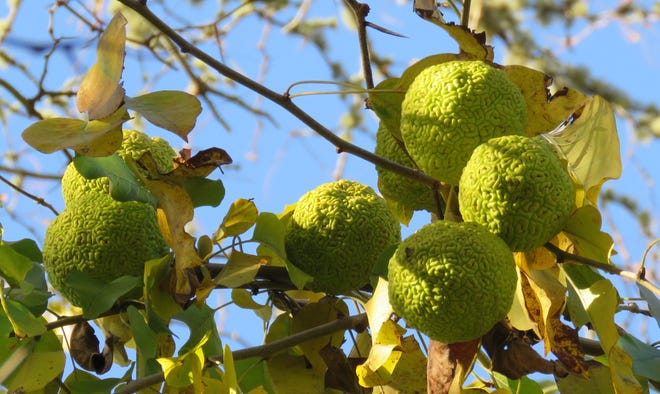Funny Looking Orange Fruit on Tree

If you take a walk in the forest around Halloween, you might just come across a bunch of what appears to be softball-sized green brains laying all over the ground.
If you look up, you may still see some of these brain blobs hanging from a tree. This very strange fruit has an interesting history that goes back tens of thousands of years.
The tree responsible for the green brain blobs is the Osage orange tree. It has also been called hedge apple, or bow dark. Each of these names can be understood better once you learn about how the tree was used historically.
Origin of the giant seed
There is only one reason a plant makes fruit — and that is to attract animals that will take the fruit for food and spread the seeds over great distances.
While a tree wants to reproduce, it does not want to have its offspring compete with the parent. Seeds surrounded by fruit allow for a greater range of distribution as animals take it to different places to eat.
Here is the interesting thing: no animal eats this large fruit. It's not that it is poisonous. It just does not taste good. Only the small seeds are eaten by small animals, and not very often.
This brings up an important question. If no animal wants to eat the fruits of the Osage orange tree, then why does the tree make them? And why are they using so much energy to make them huge?
You have to go back about 10,000 years to answer this question. While no animals eat the seeds now, they used to be delicious food for the giant mastodons and wooly mammoths that once roamed North America. They did pretty much as you would expect. They ate the giant fruit, digested the flesh, and pooped out the seeds far away from the parent tree.
More recent history
Native Americans found the tree extremely useful. While they did not eat the fruit, the wood was prized for making high-quality bows. The Osage people would travel great distances to find this wood which gave the tree the name Osage orange. Because the wood was made to make superior bows, the tree also had the name "bow dark" which is a French word that means "wood of the bow."
Later on, the trees were planted one foot apart, creating very useful hedges to keep livestock in place. The branches had small thorns on them and, when planted close, it made a perfect barrier. This is where the name "hedge apple" came from. This practice lasted a long time until barbed wire was invented in the 1870s. This invention was the end of the line for the widespread use of the Osage orange tree. However, the tree is very resistant to rotting, so it was still used as posts for the barbed wire sometimes.
Today's curiosity
Osage orange trees are now more of a curiosity than anything else, but the tree has some characteristics that make it useful. It takes a lot of strength to hold a tree of two-pound fruits. Therefore, the Osage orange tree has wood that is denser than any other wood. This makes it useful in some wood products.
The wood also has a yellow-orange color that can be boiled to make a dye. And finally, the Osage orange wood burns hotter than any other wood, and is the closest thing to coal when it comes to heat production from a tree. And just for some fun, burning Osage orange wood produces its own kind of fireworks — sparks fly when the dense wood splinters as it burns.
While the Osage orange, and the tree it comes from, is past its prime in terms of its usefulness to animals or humans, its curiosity value remains high. Next time you see one, remember the rich history of these trees and their giant fruit, then take one with you for a season and curious decoration.
Mike Szydlowski is science coordinator for Columbia Public Schools.
TIME FOR A POP QUIZ
1. Why do some plants produce fruits?
2. What happens if a plant drops all of its seeds directly below it?
3. Besides fruit, what are other ways that plants can spread their seeds away from itself?
4. Why has the spread of Osage orange trees slowed down?
5. Do you think Osage orange wood floats or sinks in water? Why?
LAST WEEK'S POP QUIZ ANSWERS
1. Humans get the energy we need from food. Where do plants get their energy from?
The sun.
2. Plants cannot directly use the sun's energy to grow. Instead, they use the sun to make what substances that the plant uses for food?
The plant makes glucose for food using the process of photosynthesis.
3. How are plants responsible for humans being on Earth?
Without plants, the Earth would not have had oxygen and animals (including humans) would not have evolved.
4. Why do leaves turn colors in the fall?
Fall colors are always in the leaf, but are overpowered by the green pigment of chlorophyll. When the days get shorter and cooler, the production of chlorophyll slows down and allows the other pigments to start to show through.
5. Even after death, how do leaves support life on Earth?
Tiny organisms break down dead leaves and turn it into nutritious top soil for other plants and animals.
Source: https://www.columbiatribune.com/story/lifestyle/2021/10/27/strange-fruit-osage-orange/8506229002/
0 Response to "Funny Looking Orange Fruit on Tree"
Post a Comment